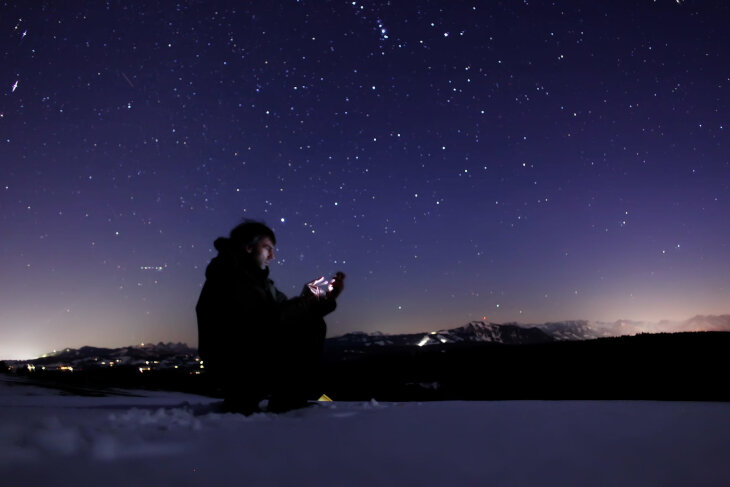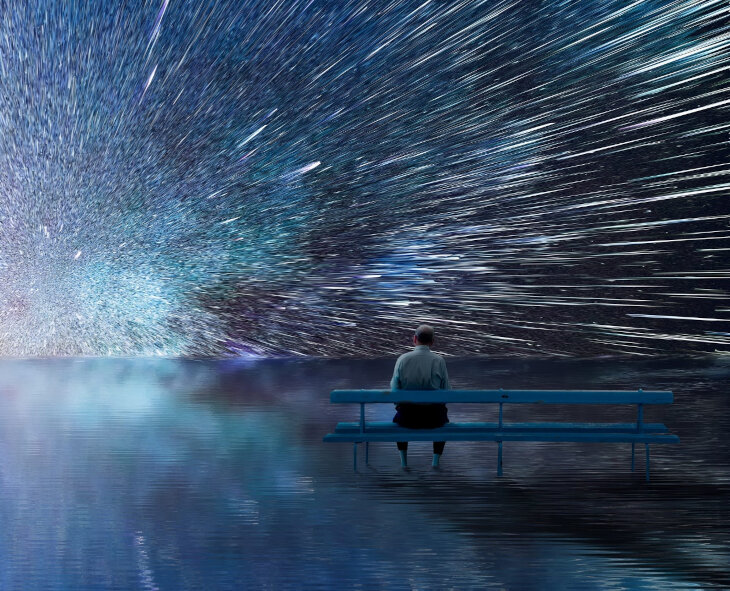 Vampire Weekend's Surprising Jewish Stories
Vampire Weekend's Surprising Jewish Stories


13 min read
Three scientific discoveries that were originally understood as proof of the Divine.
How hidden is God? Is nature completely devoid of the Creator’s fingerprints? Can the silence between God and creation only be bridged by a blind leap of faith? Or is evidence for God everywhere for those who have ears to hear and eyes to see? Within the history of science, there have been many debates over science, which—at the time—were thought to have clear implications about what would count as evidence for the existence or non-existence of God.
As such debates between rival scientific perspectives raged on, and as one theory (together with its concomitant religious view) would emerge victorious, the religious dimension of the debate would soon be forgotten. As the dust of the original disputation settled, a type of historical amnesia would set in, where the original religious lines of the debate would be lost to almost all cultural memory.

The second law of thermodynamics was formulated by the German physicist Rudolf Clausius in the early 1850s. According to this law, the entropy (or tendency towards disorder) of any closed system will inexorably increase over time, meaning that the system will eventually decay and end in a state of equilibrium. In this state of equilibrium or “heat death,” all life would cease, and all organization would dissolve.
In the late 1860s, when the second law of thermodynamics was first applied to the entire universe, it soon became apparent to physicists that, in light of the heat death scenario, the universe could have only existed for a finite period of time. And if this was the case, then it followed that the cosmos had a beginning in an extremely highly ordered state. In an era when most scientists believed that the universe was eternal, this notion came as quite a shocking surprise. Beyond that, this type of temporally finite cosmos appeared to require a transcendent someone who exquisitely ordered it and commenced it in the first place.
The second law of thermodynamics became highly controversial because it clearly suggested the existence of a Creator God who began it all.
As a consequence, the second law of thermodynamics became highly controversial because—in the opinion of pretty much everyone involved—it clearly suggested the existence of a Creator God who began it all. In the intense debate that ensued over the truth or falsehood of this law, atheistic materialists and positivists (such as Ernst Haeckel and Friedrich Engels) engaged in battle with theistic scholars and scientists (such as James Clerk Maxwell and Sir William Thomson) over the cosmological and theological consequences of thermodynamics. All the debaters assumed that the “universal law of entropy-increase” entailed a Divine creation of the world.
As historian of science Helge Kragh explains, “To Engels and most other socialist thinkers, [the second law of thermodynamics] was an unacceptable view because it left the door open for the most un-socialist of beings, the creative God.”¹ Over time, however, as evidence mounted supporting the scientific truth of the second law of thermodynamics, atheists interpreted its implications quite differently. Why does the Second Law of Thermodynamics no longer clearly prove the existence of a creator God? It would seem that the reason is essentially because the original lines of the debate were forgotten, and atheists co-opted what was once considered obvious evidence for God into a materialist worldview.

From the 16th through the 19th centuries, a great scientific debate erupted over the age of the Earth. However, this debate was markedly different than what most people today think. The primary issue of contention was whether Earth was eternal (as Aristotle had argued), with no actual history, or whether Earth had a beginning in time and was characterized by unique and non-cyclical historical ages.
Before the pertinent scientific evidence emerged to decide between the two rival theories of Earth, discussions among early geologists about the world’s timescale were deeply colored by what historian of geology Martin Rudwick calls a “clash of theologies.” As Rudwick explains: “This was not a case of ‘Religion versus Science,’ but of one religious view of the world against another.”²
At the beginning of this debate, the eternity of the cosmos was generally assumed. Aristotelian uniformitarians held that the processes of Earth were eternal and cyclical with, as anti-religious geologist James Hutton declared, “no vestige of a beginning, and no prospect of an end.”³ In the Aristotelian uniformitarian view, Earth’s processes were thought to take place on an infinite timescale.
The changes on Earth’s surface were not seen as progressive, historical, or directional but were understood to be like the incessant and regular movements of the timeless heavens. Skeptics assumed the uncreated eternity of the cosmos and the Earth and, apart from a Biblically-inspired leap of faith, no one could conceive of a time before seasons, mountains, rivers, or animals existed. ⁴
It was the Father of the Geosciences and Roman Catholic Saint, Nicholas Steno, who introduced the idea that the Earth had a history—and this idea entered the debate, not from the realm of science or philosophy, but from that of theology.⁵ Steno was the first to use science to challenge the Aristotelian view of the Earth, and, as historian of science Alan Cutler explains, he “was satisfied to give the world a linear and roughly biblical history as proof against the eternalist heresy.”⁶ After Steno, those who argued for the Earth history side of the debate were—pretty much to a person—devout believers in the truth of the Bible.
Thus when, in 1819, William Buckland obtained the first chair of geology at the University of Oxford, he stressed in his inaugural lecture that “the facts of geology were not only consistent with the accounts of the creation and the deluge as recorded by Moses but that they were also proof of the continued superintendence of the intelligence of the Creator.”⁷
Buckland, who published the first full account of a fossil dinosaur and proposed age of the Earth as “millions of millions of years,” argued there is “evidence for a period before life itself existed—that is, in the Primary rocks, with no trace of fossils.” This said, Buckland, “was enough to indicate an origin within time, and hence to refute the hypothesis of an eternal succession of causes.”
Cambridge professor of geology and Charles Darwin’s mentor, Adam Sedgwick, agreed and contended that the science of geology, “like every other science when well interpreted, lends its aid to natural religion.” From Geology, argued Sedgwick, “we learn that the manifestations of God’s power on earth have not been limited to the few thousand years of man’s existence.” Yet, he says, this does not at all “clash with our notion of the Creator” because “the repeated change in external conditions proves that he has always been actively present both in his own person and through providence.”⁸
For Buckland, Sedgwick, and other advocates of Earth’s geologic history, “the progressivist synthesis strengthened the biblical…notion of time as a directional phenomenon, against the cyclical notion of time found in Enlightenment eternalism” and “undercut the uniformitarian, steady-state model of earth…prominently defended by Lyell in his Principles of Geology.”⁹ The scientists of faith who argued that Earth had a true history believed evidence from “geology served to refute not only atheists but also deists.”¹⁰
Religiously skeptical geologists, though, such as Charles Lyell, “persisted in [their] denial that the stratigraphic record showed a progressive trend.”¹¹ According to Lyell—who also rejected Darwinian evolution— “Genesis leads straight to Darwinism,” and he saw no convincing evidence of such a historical progression of lifeforms that eventually led to humans as the crowning of creation.¹²
Both evolution and earth history were notions that betrayed a mere confusion of science with theology. Today, as the debate over an eternal planet Earth has been largely forgotten, it is truly ironic that those who argue for a “young earth” employ the same anti-evolution arguments as Lyell while those in the atheist camp have now become entirely acclimated to the biblically-rooted concepts of progressive evolution and a historical Earth with a beginning in time.¹³

When physicist and Catholic priest Georges Lemaître introduced the big bang theory to the scientific world in 1927, it was a total non-starter. Offering a physical interpretation of Einstein’s General Relativity equations, Lemaître projected the expansion of the cosmos back in time and concluded that an initial “creation-like” event must have occurred where the fabric of time and space came into existence—a point that he called the “primeval atom.” Although it was a physically and mathematically legitimate way of interpreting Einstein’s equations, Einstein himself rejected this theory as “abominable.”¹⁴
Even Edwin Hubble, whose observational data in 1929 on red-shifting stars suggested an expanding universe, found Lemaître’s big bang theory distasteful and “rather dubious.”¹⁵ Hubble called the big bang model “a forced interpretation of the observational results” and wanted nothing to do with it until his dying day.¹⁶ In 1931, the well-known physicist Arthur Eddington likewise considered Lemaître’s theory unacceptable, remarking: “Philosophically, the notion of a beginning of the present order of Nature is repugnant to me” because this is “a mere confusion between physics and the theology of creation.”¹⁷
Cambridge cosmologist Fred Hoyle agreed: “It simply cannot be a good scientific theory. Under no circumstances ought anything that sounds like a cosmic beginning be acquiesced in by the scientist.” Another physicist, Vladimir Sviderski, even went so far as to call Lemaître’s big bang model an “unscientific Popish conclusion.”¹⁸
Reflecting on this widespread rejection of the big bang theory by essentially every atheist cosmologist of the era, historian of science Helge Kragh finds it “most remarkable” that Lemaître’s theory initially made no positive impact at all. It is clear, says Kragh, that an ingrained belief in the static and eternal nature of the universe—and the rejection of a beginning—were important factors.
For the religiously skeptical scientists, a cosmic beginning implied a Creator God, and thus they would have nothing to do with it.
Beyond this, the big bang was positively ridiculed and resisted by atheist cosmologists for over 40 years. For the religiously skeptical scientists of Lemaître’s age, a cosmic beginning implied a Creator God, and thus they would have nothing to do with it. As atheist mathematician and cosmologist William Bonnor made clear in the 1950s: “The underlying motive [of the big bang theory] is, of course, to bring in God as creator…It seems like the opportunity Christian theology has been waiting for ever since science began to depose religion from the minds of rational men in the seventeenth century.” Bonner, Sviderski, Hoyle, and many others “rejected big-bang theory” mainly because “it lent support to divine creation.”¹⁹
From the 1960s through the 1990s so much evidence for the big bang accumulated that those who had long rejected it would start to appear irrational if they continued to resist. The consequence was that atheists not only acclimated to the big bang, but somehow even managed to co-opt the big bang theory as an alternative to the Biblical concept of creation and to erase Lemaître from the historical equation. For example, Stephen Hawking, in his final book, Brief Answers to Big Questions argues there’s no possibility of God existing because nothing—not even time—existed before the big bang. In fact, says Hawking “the Big Bang was an inevitable consequence of the laws of physics…making God unnecessary.”²⁰
A current website on the big bang hosted by the University of Michigan states that, “The origin of the Big Bang theory can be credited to Edwin Hubble” and there is no mention of Lemaître at all.²¹ Through a cultural and journalistic sleight of hand the big bang is no longer regarded as evidence for God, and in some cases it is even presented as evidence against God. And no one—at least at the popular level—appears to notice.
Such cases of selective amnesia in the history of science reveal how short-lived cultural memory is and how susceptible it is to buying into repackaged old ideas marketed under a new brand name—even if such ideas were once those of their chief competitor. These case studies are merely a few of the many instances where cultural institutions that support unbelief have rewritten the history of science to their own ends—reworking what was once viewed as clear evidence for God into evidence for the opposite.
These cultural forces changed the rules of the game at the very moment when the competition was about to close so that the vanquished could be proclaimed the post hoc victor. Today the intellectual heirs of these historical illusionists of science rhetorically ask: “Where is the evidence for God?” Protesting doggedly against rational belief in God and trusting a ruse of their ancestors’ fashioning, they are “a people who are blind, yet have eyes, and are deaf, yet have ears.”
For more content like this, please visit www.beyondbelief.blog
